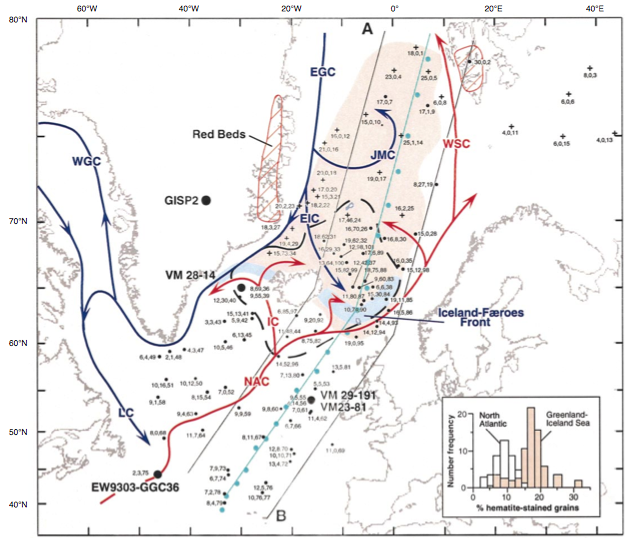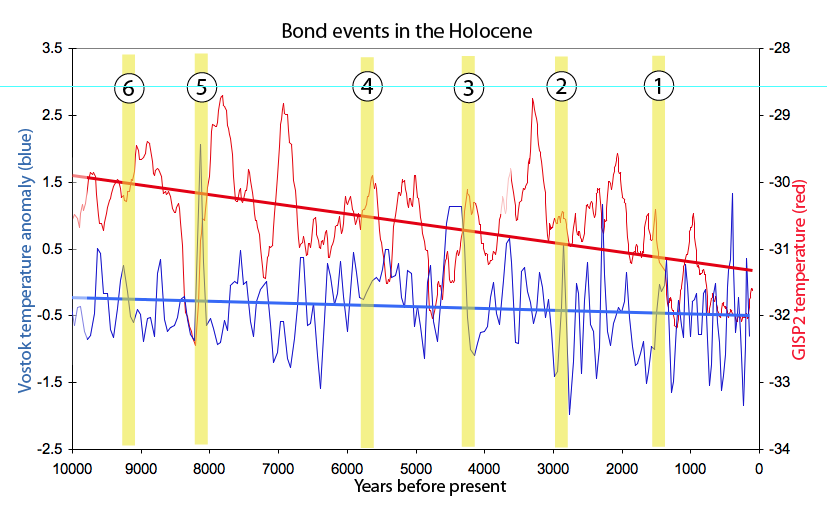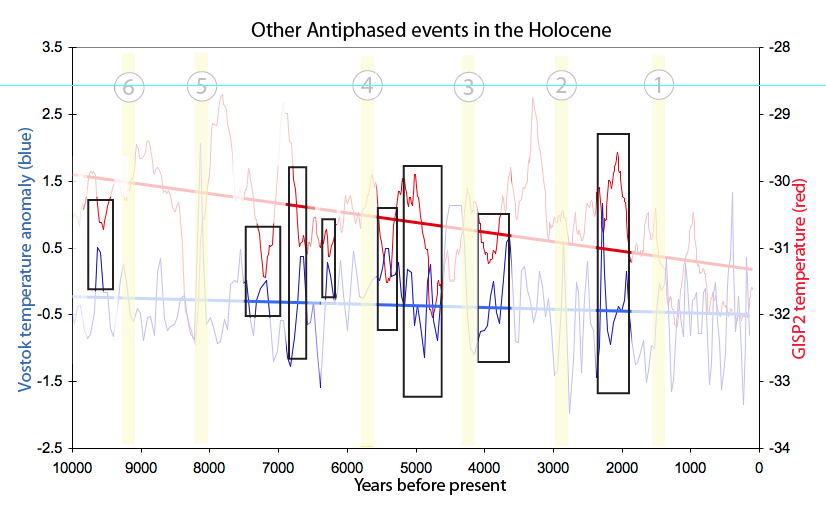The name is Bond...Gerard Bond.
Posted on 12 March 2011 by Rob Honeycutt
One of the main climate skeptic claims when presenting the Greenland Ice Sheet Project 2 (GISP2) record is that climate change during the Holocene is normal, that there is nothing new about the warming we see today. This is not a claim that is substantiated by the full body of research. We're going to take out a "license to kill" this particular skeptic meme.
The name is Bond...Gerard Bond.
Specifically, Bond et al 1997 titled A Pervasive Millennial-Scale Cycle in North Atlantic Holocene and Glacial Climates. Okay, this Bond doesn't quite have Ian Fleming's knack for a catchy titles but we'll work with it.
Many of you may be familiar with Dansgaard-Oeschger (D-O) events. These are the rapid climate change events we see in the ice core data during glacial periods. They are easily recognizable in the GISP2 core by rapid warming followed by slower cooling, following an aproximately 1470 year cycle. D-O events are also notable in the climate record as being a redistribution within the climate system because they are also found in Antarctic cores with a corresponding but reverse signal (called an "antiphase"). That is, offsetting warming and cooling between the Arctic and Antarctic. This is not the planet heating up suddenly and then cooling off. It's the planet rearranging how heat is distributed within the overall climate system. This is often referred to as a "bipolar seesaw."
Shaken, not stirred.... Ice-Rafted Debris
Bond et al takes a look at the Holocene and identifies a similar, but lesser, bipolar seesaw effect at work. The work is primarily done by looking at ice-rafted debris (IRD) in sea bottom cores around the North Atlantic. During warming events more ice calves off glaciers and with that ice comes debris that is distributed on the sea floor as the ice melts. Bond et al look at the distance of flow patterns of this debris as it's distributed on the sea floor. These are referred to as "pulse" events in sea bottom cores and the timing of these deposits are then correlated with warming events the GISP2 ice core record.

Fig 1 - Core locations and NA currents from Bond et al 1997
There are 8 primary Bond events, at 1,400, 2,800, 4,200, 5,900, 8,100, 9,400, 10,300, and 11,100 years ago. Here we are going to stick with just the 6 events that fall within the Holocene.

Fig 2 - Six Bond events identified through Ice-Rafted Debris (Click for larger image)
The most dramatic of these is the "8.2 kyr" event, Bond event 5. There is a reverse event which is quite dramatic in the Vostok ice core. If we further compare the GISP2 and Vostok temperature records we can see a very large number of antiphased events, though these are not specifically identified as Bond events.

Fig 3 - Numerous other antiphased events in the ice core records (Click for larger image)
There is still much that is not well understood about what drives both D-O and Bond events. There is still a great deal of debate on whether they are actually cyclical or coincidental, and what forcing might be driving them. Recent research such as Maslin 2009 is beginning to better clarify the bipolar nature of the Holocene.
Why yes, Miss Moneypenny...
Those of you who are observant will note several important events these two records point out. It's notable to see that the Medieval Warm Period around 800–1,000 years BP is quite dramatic in the Greenland record but is not evident in the Antarctic record. There is also the so called Roman Warm Period around 2,000 years BP that clearly has a reverse response in the Vostok core.
When we start reconciling these records we find, yes, there are dramatic and rapid climate change events in the Holocene. Larger changes tend to occur in the high latitudes of the northern hemisphere while the southern hemisphere remains more stable with occasional redistributions of temperature from the north. We often see dramatic changes in temperature in a single location but this doesn't represent change in the global climate as much as it represents a redistribution of temperature.
Proxy Galore
What we learn from Bond events is global climate is still dynamic during the Holocene, though profoundly less so than glacial periods. Looking at any one proxy record of temperature, like the GISP2 ice core, will only tell us about the climate of that location. Scientific understanding of global temperature in the past requires looking at a wide range of proxies.
What differs today is that we see nearly all records and indicators of temperature rising, whether it's glaciers melting, ice mass loss, patterns of animal migrations, ocean acidification, intensification of precipitation events, or many other lines of evidence. Today these are nearly all collectively pointing in only one direction. They are telling us unequivocally (per the language of the IPCC) that we are warming the entire planet... potentially with a "view to a kill."































 Arguments
Arguments






























For images, look under the section that says IMPORTANT. Copy the html tag string that appears there into your comment box, insert your desired url string for your link source between the double-quote marks and then Bob's-your-uncle (you're ready-to-go).
1a href="http://geography.cz/sbornik/wp-content/uploads/2009/09/g08-4-1wanner.pdf"2http://geography.cz/sbornik/wp-content/uploads/2009/09/g08-4-1wanner.pdf1/a2
or1a href="http://geography.cz/sbornik/wp-content/uploads/2009/09/g08-4-1wanner.pdf"2Here's a link to an interesting study I found1/a2
Which (substituting the appropriate arrows back in for the 1's & 2's) yields:Here's a link to an interesting study I found
I figured it out, eventually. If I can, anybody can.